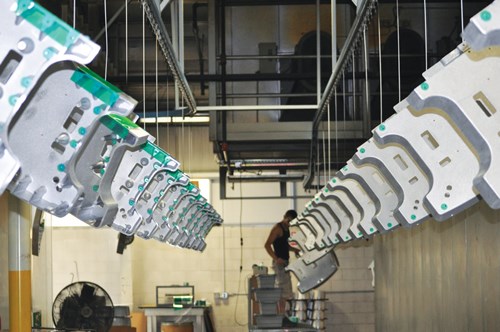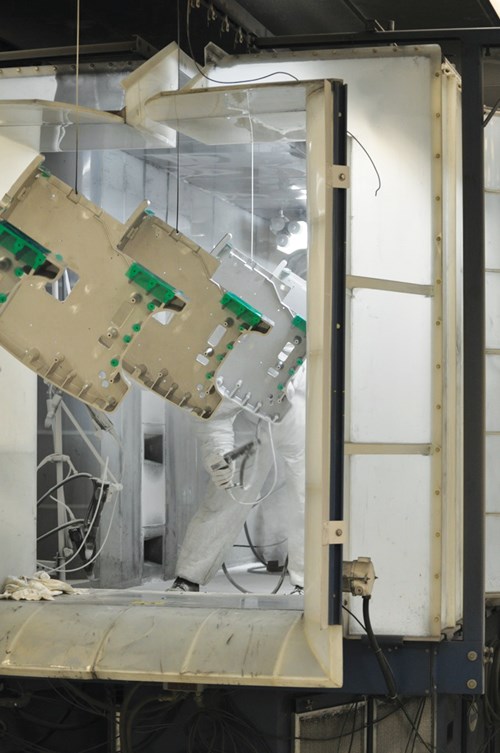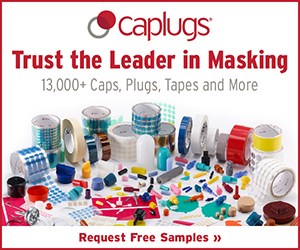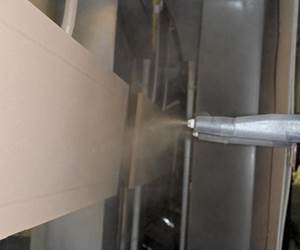Manufacturer-Turned-Powder Coater Means Value Added
Wisconsin foundry adds value to parts produced with powder coating line.
Before roughly 2000, castings maker Watry Industries was watching about $500,000 a year in powder coating work go out its doors in Sheboygan, Wis., as it outsourced the finishing work on many of its customers’ parts.
That all changed when the large, permanent mold aluminum foundry brought the work inside and installed its own powder coating line.
“We had customers who only wanted a single source to get a fully machined, painted casting,” says Wayne Bennin, sales manager for Watry. “From a timing and quality standpoint, it just made sense for us to do it ourselves.”
With an overhead, conveyorized, powder coating operation that begins with a seven-stage wash system, Watry is able to process parts as large as 36 × 54 × 54 inches weighing as much as 100 lbs. or more. The all-stainless-steel washer includes a deionized (DI) rinse and DI halo in the final stages to achieve the highest level of cleanliness.
One Vendor
“Because we’re machining and then painting these parts, our customer only has to deal with one vendor, and we’re happy to have single-source responsibility for that,” Bennin says.
Now in 2012, Watry not only is providing its customers with well-built aluminum castings and a durable finish, but the company also has become increasingly involved in the design and engineering of its customers’ castings products at its 272,000-sq-ft facility.
Take for example a large manufacturer of medical equipment that had been a Watry customer for years but was changing a design on an anesthesia machine. The company designs and builds various medical devices, typically structural components of patient care equipment such as anesthesia machines, ventilators, EKG carts and other applications.
Watry’s client was redesigning the base of the device, which supports the weight of the unit, including large gas cylinders for certain applications. The new design had to support substantial mechanical loads and also meet tough cosmetic requirements required of top-end medical equipment.
Bennin said Watry worked closely with its customer to assist in the design process for this part as well as two other castings used on the same program, from concept through tooling and into production.
Model Castings
“Powder coating was a foregone conclusion because we had worked on similar parts before, but it was important for the customer to help get it designed right, too,” Bennin says. “Our engineers worked closely with their staff to model the casting and see exactly what would work best and hold up the best.”
Watry General Manager Jason Dannenberg says several other production processes were considered for making the part, including injection-molded plastic, structural foam and plastic cowling over steel fabrication, as well as several casting processes such as sand cast, permanent mold and high-pressure die cast.
After investigating those options, mechanical strength concerns eliminated some of the plastic construction methods, and a thorough cost analysis eliminated the fabrication options as being too expensive, Dannenberg says.
“Aluminum castings had a proven track record in similar applications, and a cost analysis was done to compare the various cast processes,” he says.
Based on the combination of part cost and tooling cost—meaning the total cost of ownership—permanent mold was selected as the best process for the application, Bennin says.
Solidification Modeling Software
Subsequently, Watry’s engineers participated in technical reviews of the part with the customer’s engineering group, and used solidification modeling software to analyze the part and gating design as well as determine optimum process parameters.
That analysis led to various design changes, which were incorporated into the part before the mold was built. The result of the joint engineering effort was that Watry produced suitable castings that were heat treated, machined and powder coated in-house.
But it has been Watry’s great success in its powder coating booth that has resulted in other casting foundries actually coming to the company for out-sourced finishing work.
“We’re getting calls from a lot of machine shops and extrusion houses,” Bennin says.
According to Dannenberg, the work done on the Watry powder coating line is 50-50 inside and outside jobs. The company does have extra line capacity and is actively looking for additional powder coating work. It has one Nordson booth already installed and has an environmental room large enough to install a second booth without having to expand the facility.
“Right now we have one shift running, so we have an entire second shift of capacity that we are looking to fill, and we’re talking with some other companies about that,” Bennin says.
Dannenberg says the company has been speaking to other foundries, metal stampers, metal fabricators and any other business whose products it can powder coat on a contract basis.
“We can coat castings or any substrate made by other processes as well as steel, iron and various alloys,” he says.
Both Dannenberg and Bennin know that pretreatment of the product is the key to proper paint adhesion, so they maintain washer chemical stages within strict limits, even monitoring them on a daily basis.
Watry’s facility also is capable of masking features before coating as well as blowing off uncured powder in areas where masking is not practical. Bennin says its Nordson Cyclo-Kinetic reclaim booth—using both manual and automatic guns—is capable of applying the most demanding and high-temperature powders, reaching the most difficult areas on any workpiece.
Large and Heavy Parts
Watry’s roof-mounted cure oven, which encompasses more than 250 ft. of conveyor track and operates at temperatures up to 500°F, can cure powder on the largest and heaviest parts at very high line speeds, providing another cost-controlling feature, Dannenberg says.
Watry also is a stickler for quantitative analysis of the finished parts, using strict quality control systems and procedures, including film thickness checks, adhesion testing, color verification and paint hardness testing, to ensure compliance to customer requirements.
In addition to powder coating services, Watry offers further value-adding capabilities, such as in-house machining, bar coding, special marking, pad print logos, symbols and text over the powder-coated finish; silk screening of larger details; and light assembly.
“This past May was the busiest we’ve been on the powder coating line,” Bennin says. “But there’s more we can do, so we’re ready when someone calls us.”n
To learn more about Watry Industries, please visit Watry.com
Related Content
Understanding Infrared Line-of-Sight
Marty Sawyer of Trimac Industrial Systems offers insights into using infrared to accelerate your powder coating curing operations.
Read MoreHow Not to Cure Powder on MDF
Mike Chapman, chief strategic officer at WolfRayet, an industrial oven provider for heat-sensitive substrates, discusses the correct procedures and common pitfalls when curing powder coating on MDF.
Read MoreHigh-Temperature Oven Lubricants Utilize White Graphite
Bio-Extreme, High-Temperature Oven Lubricants from Renewable Lubricants utilize white graphite to improve lubricant quality.
Read MorePowder Coat MDF for an Enviable Finished Product
Cabinet maker says powder coating on wood offers more benefits.
Read MoreRead Next
Navy Is Full Steam Ahead On Powder Coating
With the military increasing its use of powder-based coatings to cover vehicles, equipment and ships—the Army has recently announced that it will allow the use of powder coatings in its CARC coverings that are normally e-coated—more assets are getting the powder coating treatment than ever before, much to the joy of the powder manufacturers.
Read MorePowder Coating 4.0: Smarter, Faster, More Efficient and Connected
New tools reduce cost and waste, lower manufacturing footprint of powder coating operations.
Read MoreThe 2024 Ford Mustang: All the Colors Available
Although Chevrolet has announced the end of the Camaro and Dodge is offering “Last Call” editions of the Charger and Challenger, the Ford Mustang is launching to its seventh generation.
Read More
































